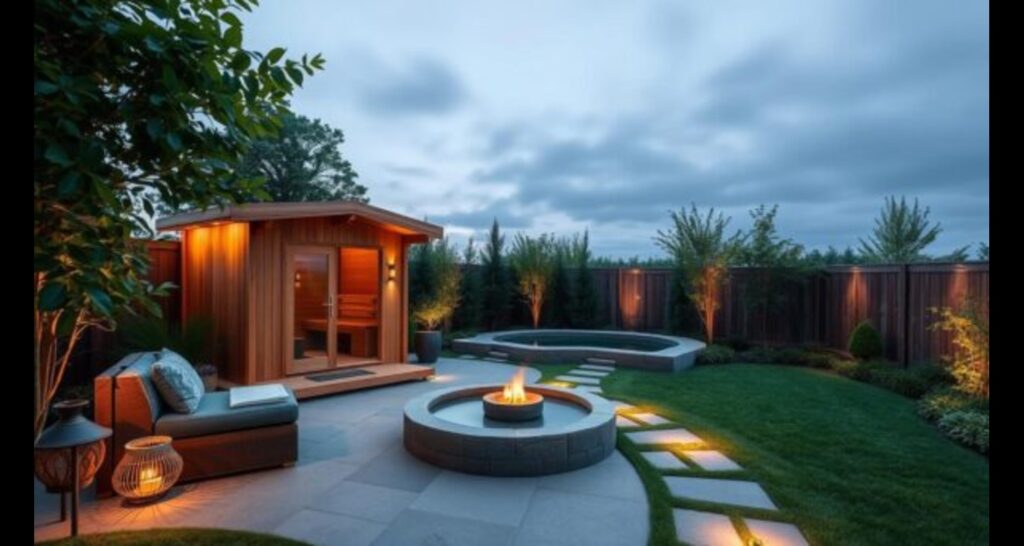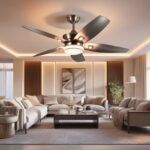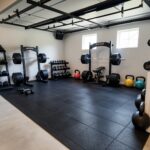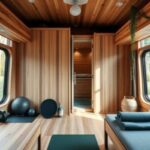Ever thought of turning your backyard into a wellness paradise? A backyard sauna could be just what you need. It’s a place for relaxation and health, right in your own yard. You can choose from wood-burning saunas or modern infrared ones, making your outdoor space a personal retreat.
Creating a backyard sauna requires some planning. You’ll need to decide on the best spot, size, materials, and features. Whether you want a standalone sauna or one that blends with your yard, there are many options.
An outdoor sauna is great for any time of the year. It’s perfect for unwinding after a workout, relieving stress, or just hanging out with loved ones. With prices from $3,000 to $6,000, setting up your own sauna is easier than you think.
Table of Contents
Key Takeaways
- Backyard saunas offer versatile use for relaxation and health benefits
- Proper planning is crucial for location, size, and material selection
- Outdoor saunas can accommodate 4-10 people depending on design
- Various styles are available, from traditional to modern designs
- Integration with other outdoor features enhances the overall experience
- Costs range from $3,000 to $6,000 for sauna kits on average
- Installation times vary from hours to weeks based on complexity
Understanding the Benefits of a Backyard Sauna
A backyard sauna brings many health benefits, making it great for your outdoor wellness. It’s a private spot for relaxation and rejuvenation all year round.
Using a sauna regularly can lower stress and improve your overall well-being. The heat boosts blood flow, helping nutrients and oxygen reach your tissues. This improves your immune system by better transporting antibodies.
Saunas can also increase endorphins, helping with pain relief. The peaceful setting reduces stress and pain, offering a natural way to relax. Saunas also help build connections with friends and family.
“Embracing the calm in a sauna setting can provide mental relief, lowering stress levels and reducing the perception of pain.”
There are many outdoor sauna types to choose from:
- Wood-burning Saunas: Traditional experience using wood as heat source
- Electric Saunas: Modern option, popular for easy installation
- Infrared Saunas: Energy-efficient choice offering gentle heating
| Benefit | Description |
|---|---|
| Cardiovascular Health | Improved heart function and circulation |
| Muscle Relief | Eases sore muscles and joints |
| Skin Health | Enhanced skin tone and texture |
| Stress Relief | Reduces stress and promotes relaxation |
Adding a sauna to your backyard creates a special space for relaxation and wellness. This investment in your health leads to better physical and mental health.
Choosing the Perfect Location for Your Outdoor Sauna
Finding the right spot for your backyard sauna is key to a peaceful retreat. The best sauna spot can make your experience better and fit well with your backyard layout. Let’s look at important things to think about when picking where to put your outdoor sauna.
Considering Privacy and Accessibility
Privacy is very important when picking a spot for your sauna. Use trees or shrubs to make a private area. Make sure the ground is flat and stable for safety. Also, make paths easy to walk, especially for those who have trouble moving.
Integrating with Existing Landscape Features
Make your sauna fit well with your backyard by thinking about what’s already there. Put it near pools or ponds for a spa feel. Garden corners are great for privacy and saving space, perfect for small backyards.
Maximizing Natural Views
Make your sauna experience better by using the views around you. Place it where you can see the best of your landscape. Think about the sun’s path to stay comfortable. Also, protect it from strong winds to keep it peaceful.
| Location | Advantages | Considerations |
|---|---|---|
| Near Water Features | Relaxing atmosphere, Therapeutic benefits | Moisture control, Safety measures |
| Garden Corner | Privacy, Space-efficient | Accessibility, Utility connections |
| Sunlit Area | Natural warmth, Vitamin D exposure | Overheating risk, Shade options |
The best sauna spot is one that works well, is private, and looks good. Think about your climate, what you like, and how big your backyard is. With careful planning, your outdoor sauna will be a special part of your home.
Determining the Ideal Size and Layout
When planning your backyard sauna, it’s important to think about size and layout. A good size for a sauna that fits two to three people is usually 4′ x 6′ to 5′ x 7′. This size offers enough room for comfort and keeps the atmosphere cozy.
The design of the sauna benches is key to using space well and making it relaxing. Each person should have about 2 feet of bench space. The lower bench should be 400-500 mm from the floor, with the same distance to the upper bench. This setup helps with heat flow and makes moving around easy.
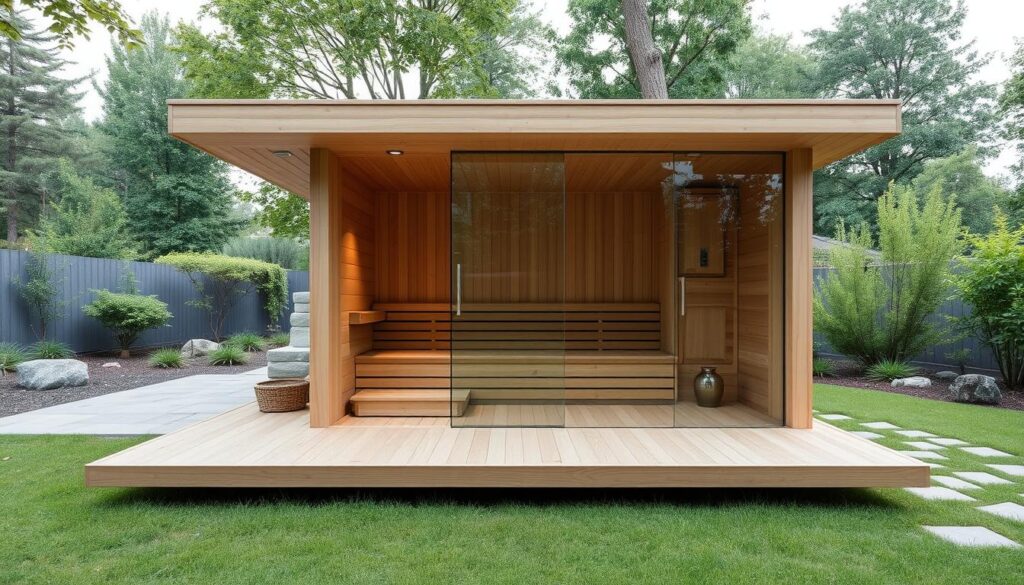
The height of the ceiling is also important in sauna design. The minimum height allowed is 77 inches, but 84 inches is better for more space. This extra height helps with air flow and makes the sauna comfortable for taller people.
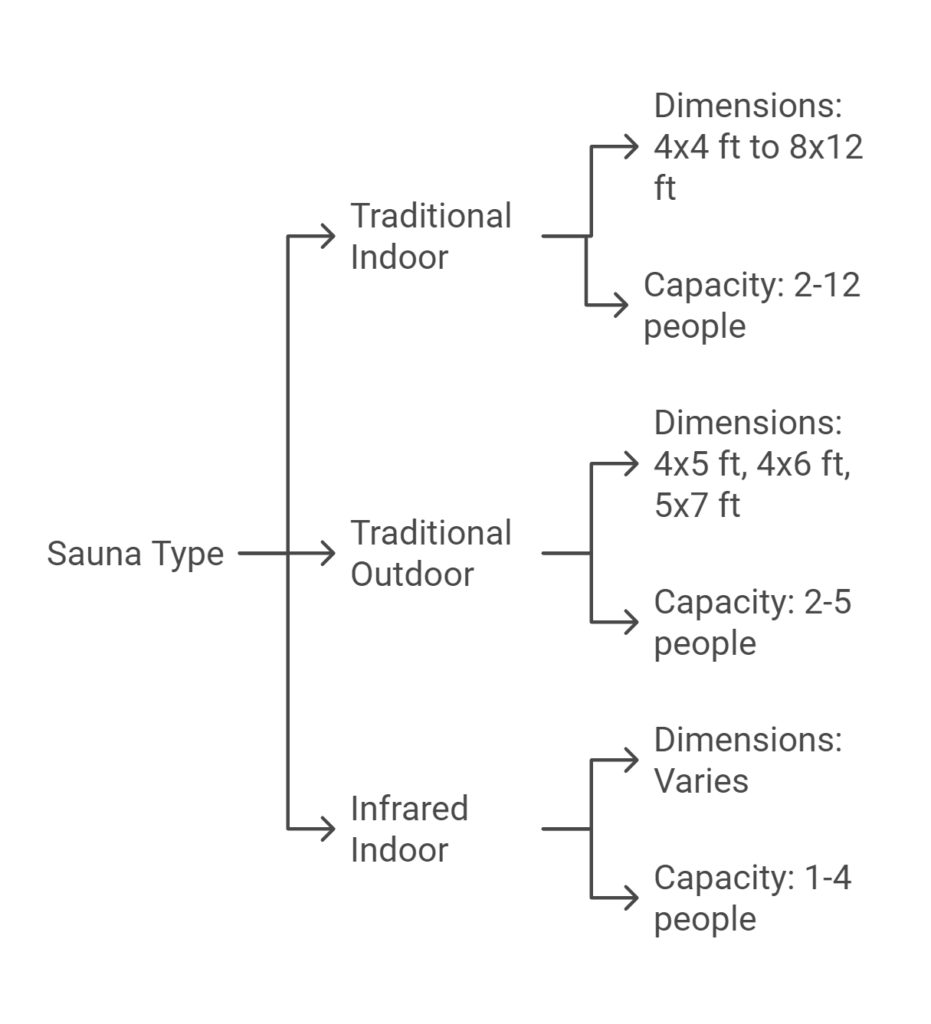
| Sauna Type | Typical Dimensions | Capacity |
|---|---|---|
| Traditional Indoor | 4×4 ft to 8×12 ft | 2-12 people |
| Traditional Outdoor | 4×5 ft, 4×6 ft, 5×7 ft | 2-5 people |
| Infrared Indoor | Varies | 1-4 people |
Custom-sized saunas can fit into unique spaces. Whether it’s under a stairwell or in a tiny home, the right size can make your sauna dream come true. By thinking carefully about these factors, you’ll create a sauna that’s both useful and welcoming.
Selecting the Right Materials for Your Backyard Sauna
Choosing the right materials for your backyard sauna is key. It affects durability, performance, and comfort. Let’s look at the main points of sauna construction materials.
Wood Options for Sauna Construction
Thermally modified spruce is a top pick for outdoor saunas. It’s treated to resist moisture and temperature changes. Cedar, pine, and aspen are also favorites, each with its own special traits.
Insulation and Moisture Barriers
Good thermal insulation keeps your sauna warm and energy-efficient. High-quality insulation materials trap heat and prevent moisture damage. Moisture-resistant materials like vapor barriers protect the sauna from humidity.
Flooring Considerations
Sauna flooring needs to handle high temperatures and moisture. Cedar is a favorite for its durability and nice smell. Slip-resistant tiles or thermally modified wood are also great for safe, lasting floors.
| Material | Pros | Cons |
|---|---|---|
| Thermally Modified Spruce | Highly durable, moisture-resistant | Higher cost |
| Cedar | Natural aroma, insect-resistant | Can be expensive |
| Pine | Affordable, widely available | Less durable than other options |
| Aspen | Light color, splinter-free | Less aromatic than cedar |
Ventilation and Air Flow in Your Outdoor Sauna
Good ventilation is key for a comfy and safe sauna time. It makes sure heat spreads out right and stops moisture from building up. Your outdoor sauna should have air flow of 2 L/s/m2 for the best experience.
To get air moving well, put an inlet vent at the stove’s base near the floor. Then, add an outlet vent diagonally from the stove, in the room’s lower third. This setup helps heat spread out evenly.
When making your portable home sauna, stay away from big recesses or sticking-out parts. They can block air flow. Shapes like rounds or curves help air move better and heat spread evenly.
Think about adding a small window or a vent that you can adjust. It boosts air flow and lets you control humidity. Saunas should have humidity around 10%, unlike your home’s 40-50%.
| Ventilation Benefits | Description |
|---|---|
| Even Heat Distribution | Promotes consistent temperature throughout the sauna |
| Moisture Control | Reduces risk of water damage and mold growth |
| Improved Longevity | Eliminates moisture and circulates oxygen, extending sauna life |
| Energy Efficiency | Recirculating heat can lower home heating costs |
Focus on good ventilation in your outdoor sauna design. It makes your sauna time better and longer-lasting.
Heating Options for Your Backyard Sauna
Choosing the right heating system for your backyard sauna is key to a perfect relaxation space. Let’s look at the main options and their benefits.
Electric Heaters vs. Wood-Burning Stoves
Electric sauna heaters are popular for home saunas. They’re easy to use and maintain. A 4.5 kW electric heater costs about $0.93 per hour to run.
Wood-burning saunas offer a traditional experience. They’re common in outdoor settings, especially for Finnish-style saunas. Softwood for these stoves costs around $300 per cord, while hardwood can be $600 or more.
Infrared Sauna Technology
Infrared saunas use a different heating method. They warm your body directly with infrared light. These saunas heat up quickly, usually in 10-15 minutes.
They’re also energy-efficient, using only $10 to $15 worth of energy per month.
Energy Efficiency Considerations
When picking a sauna heater, think about energy use. Gas sauna heaters (40k BTU) cost about $0.58 per hour to run. Electric heaters use more energy but offer convenience.
Infrared saunas are the most energy-efficient option.
| Heater Type | Average Hourly Cost | Monthly Cost (4 uses/week) | Yearly Cost |
|---|---|---|---|
| Gas (40k BTU) | $0.58 | $9.28 | $111.36 |
| Electric (4.5 kW) | $0.93 | $14.88 | $178.56 |
| Infrared | N/A | $10-$15 | $120-$180 |
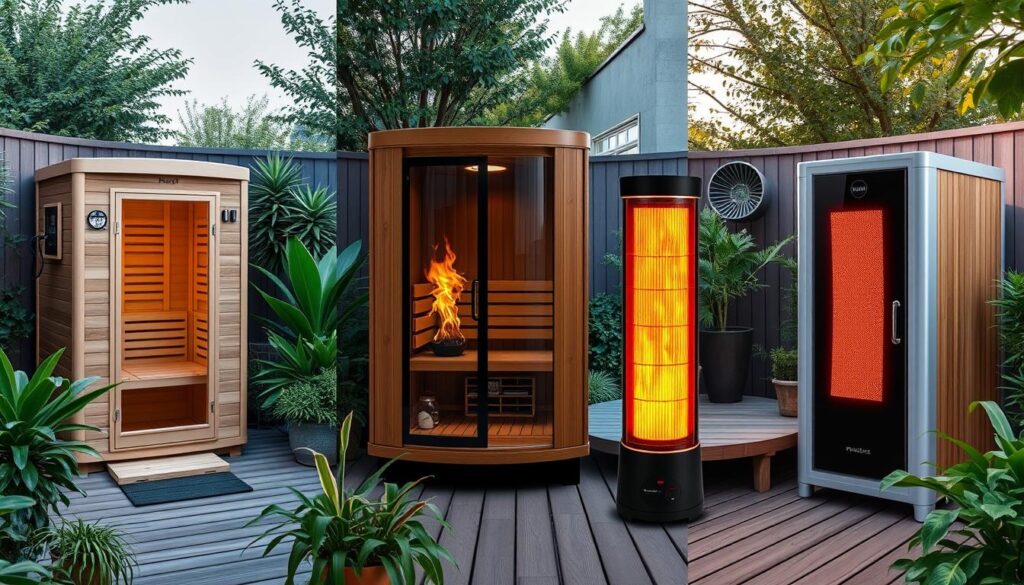
Your choice of sauna heater depends on your preferences, budget, and local regulations. Consider these factors to create the perfect backyard sauna experience.
Designing the Interior for Ultimate Relaxation
Start by choosing comfortable seating for your sauna. Benches should be at least 600 mm wide for each person. They should be 2000 mm long for lying down. The sauna should be 2100-2300 mm high. This leaves enough space for sitting upright.
Use soothing colors and natural materials to make your space relaxing. Cedar wood is great because it’s durable and smells nice. Apply wood preservative twice a year to keep it looking good. Cool stone floors are a good choice to contrast with the warm wooden walls.
Add comfort with the right sauna accessories. Headrests, backrests, and drink holders are practical. An aromatherapy dispenser can make the atmosphere calm. Soft lighting, like rustic pendant lights, adds to the peaceful feel.
Choose a design that fits your outdoor space. Whether it’s rustic, modern, or minimalist, make sure it matches your style. Don’t forget to include wicker baskets for storage and plush towels for comfort.
| Design Element | Recommendation | Benefit |
|---|---|---|
| Bench Length | 600 mm per person | Comfortable seating |
| Sauna Height | 2100-2300 mm | Optimal experience |
| Wood Type | Cedar | Durability and aroma |
| Lighting | Soft, rustic pendants | Relaxing ambiance |
Lighting and Ambiance in Your Sauna Space
Creating the perfect atmosphere in your sauna involves careful consideration of lighting. The right sauna lighting can enhance relaxation, promote safety, and complement the therapeutic effects of heat. Let’s explore how to achieve the ideal ambiance in your sauna retreat.
Natural Light Integration
Incorporating natural light sauna design can significantly enhance your sauna experience. Windows or skylights allow sunlight to filter in, creating a connection with the outdoors. This natural illumination can help reduce stress and improve overall well-being during your sauna sessions.
Artificial Lighting Options
When natural light is limited, artificial lighting steps in to create the desired atmosphere. LED strip lighting has gained popularity for its efficiency and adaptability. These flexible lights can withstand high temperatures and humidity, making them ideal for sauna environments.
- LED Light Bars: Offer up to 10,000 hours of illumination with flexible mounting options.
- Mood Lighting: Provides chromotherapy options to enhance the sauna experience.
- Ceiling Spotlights: Perfect for accent lighting, illuminating specific areas like heaters or backrests.
- Downlights: Suitable for general illumination, available in fire-rated and IP-rated variations.
Creating a Soothing Atmosphere
Mood lighting plays a crucial role in establishing a relaxing ambiance. Different colors can influence your sauna experience:
| Color | Effect |
|---|---|
| Warm Colors (Red, Orange) | Promote energy and vitality |
| Cool Colors (Blue, Green) | Induce calmness and reduce stress |
| Infrared Red | Enhance energy levels |
Remember to position lighting fixtures away from the sauna heater to prevent damage and ensure safety. With the right combination of natural and artificial lighting, you can create a soothing sauna space that maximizes relaxation and wellness benefits.
Incorporating Additional Features and Amenities
Make your backyard sauna even better with some extra touches. An outdoor shower right next to it is a great idea. It’s not just useful; it’s something 42% of homebuyers really want, says the National Association of Realtors.
Think about adding a plunge pool for a full spa experience. This cool water option can make your home worth 50-80% more. An infrared sauna is also a good choice because it’s cooler. Cedar wood is perfect for saunas because it resists moisture and smells nice.
Lighting and sound systems can make your sauna feel luxurious. These features are a big hit with buyers. Plus, having a changing room or a place to relax nearby makes your backyard a true wellness haven. Adding these extras can really boost your home’s appeal and value.

